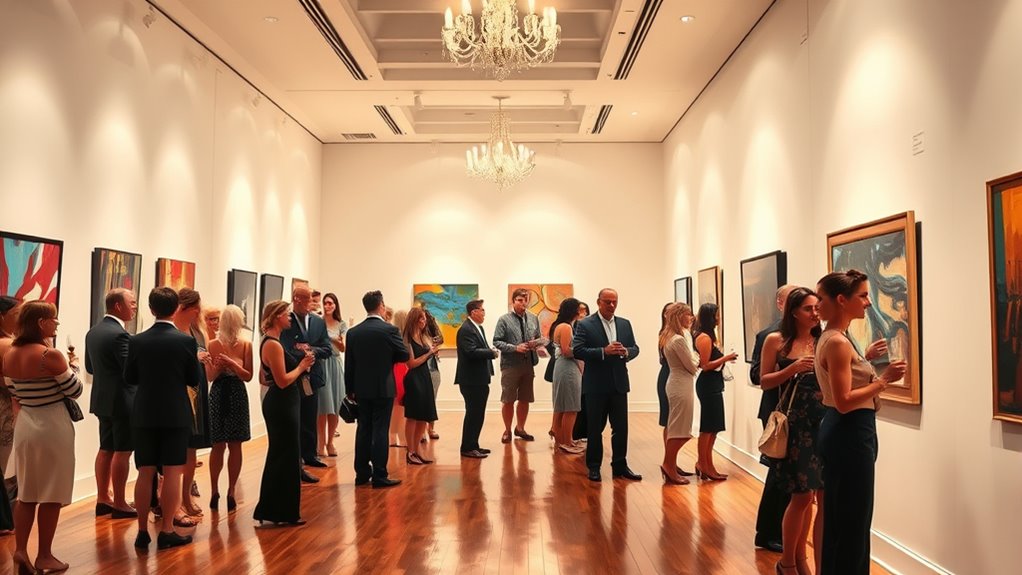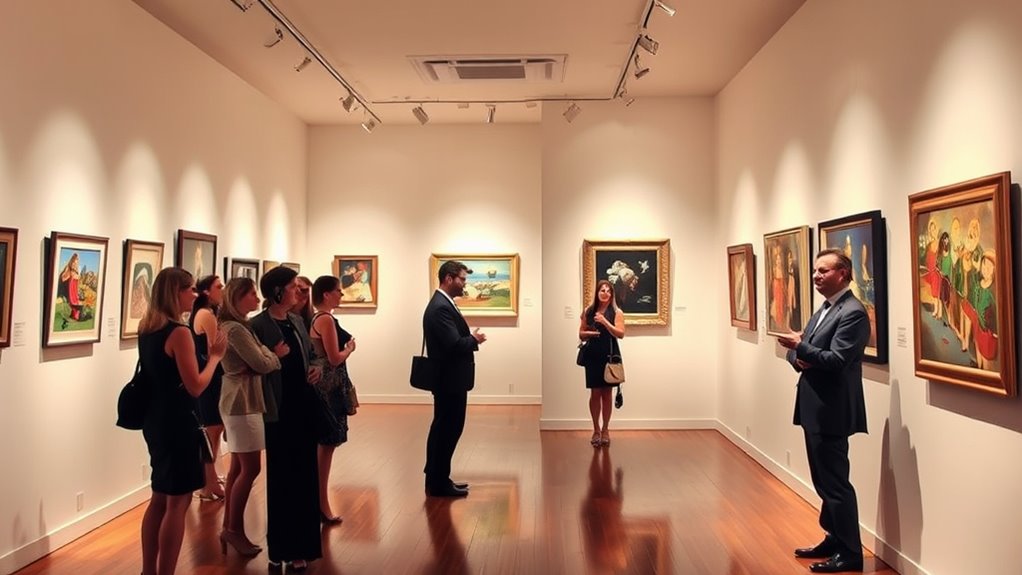When attending an art opening, you should respect the gallery’s rules to guarantee a positive experience. Keep noise to a minimum and avoid touching any artworks unless permitted. Dress appropriately, usually neat and respectful clothing, and follow any specific dress codes. Be mindful of lighting—don’t use flash or bright lights near the art—and move slowly to appreciate each piece. Following these guidelines helps protect the art and creates a welcoming atmosphere for everyone, and there’s more to discover as you continue your visit.
Key Takeaways
- Dress appropriately in neat, respectful attire, following any specified dress code for the event.
- Keep conversations quiet and maintain a respectful volume to avoid disturbing others.
- Avoid touching artworks unless explicitly permitted; follow signage and gallery staff instructions.
- Use low-brightness settings on your camera and avoid direct flash or bright lights on art pieces.
- Move slowly and thoughtfully, respecting the gallery’s lighting and environment to protect the artworks.

Visiting an art gallery can be an inspiring experience, but knowing proper etiquette helps guarantee everyone enjoys the space. One of the first things to pay attention to is how the gallery is lit. Museums and galleries often use carefully designed lighting, known as museum lighting, to highlight artworks and set the right mood. When you’re inside, avoid using flash photography or pointing bright lights directly at the art, as this can damage delicate pieces over time. Keep your own phone or camera at a low brightness setting, and be mindful of others around you. Respecting the lighting setup ensures the art remains preserved and that everyone can appreciate it in the way the curator intended. Proper lighting also minimizes the risk of accidental damage caused by bright or harsh illumination. Additionally, being aware of art preservation techniques helps you understand the importance of proper lighting in maintaining the integrity of artworks.
Respect the gallery’s lighting by avoiding flash and keeping devices at low brightness to protect the artwork.
Another essential aspect is dressing appropriately. Many galleries have a dress code, especially for special exhibitions or opening nights. This doesn’t mean you need formal attire, but it’s best to avoid overly casual or revealing clothing. Aim for neat, comfortable, and respectful attire — think smart casual. Wearing clean, modest clothing shows respect for the artwork and the other visitors. If the event specifies a dress code, such as business casual or cocktail attire, make sure to adhere to it. Your outfit sets the tone for the evening and helps maintain the gallery’s atmosphere of reverence for the art.
As you navigate the gallery, remember that your behavior influences everyone’s experience. Keep your voice at a considerate volume so conversations don’t disturb others who are quietly contemplating the artworks. Refrain from touching the art unless explicitly allowed, and always follow signage or instructions from gallery staff. If you’re unsure about a rule or guideline, it’s better to ask politely rather than assume. Paying attention to the environment — from lighting to dress code — shows respect for the space, the artworks, and fellow visitors. Practicing gallery etiquette not only enhances your own experience but also fosters a respectful environment for all guests.
Lastly, don’t forget to give yourself time to absorb the art without rushing. Move slowly and thoughtfully, allowing each piece to make its impression. By respecting the gallery’s lighting, adhering to the dress code, and practicing courteous behavior, you ensure a positive experience for yourself and everyone else. These small acts of consideration help keep art spaces welcoming and inspiring, fostering a deeper connection with the creative works on display. Observing proper behavior guidelines also helps protect the integrity of the artworks for future visitors.
Frequently Asked Questions
How Should I Dress for an Art Opening?
When attending an art opening, you should consider the dress code and fashion expectations. Opt for smart-casual attire that reflects your personal style while remaining polished. Avoid overly casual or revealing clothing, as galleries often lean toward sophisticated ambiance. Think neat, well-fitted pieces, and perhaps add a subtle accessory to elevate your look. Dressing appropriately helps you blend into the artistic environment and shows respect for the event.
Is Photography Allowed Inside the Gallery?
Like a whisper in a silent room, your curiosity about photography stirs. Usually, galleries set camera restrictions to protect artwork, and you’ll find flash photography is often off-limits to prevent damage. So, check the gallery’s rules before snapping shots. Respect these guidelines as they guard the delicate beauty around you. If in doubt, ask staff—your respectful curiosity keeps the art alive and the experience enriching.
Can I Bring Children to the Opening?
You can usually bring children to the opening, but verify the gallery’s family-friendly policies first. Many galleries welcome families, but they ask for child supervision to ensure the art stays protected. Keep an eye on your kids, and consider bringing snacks or activities to keep them engaged. Always confirm if there are specific age restrictions or guidelines, so everyone has an enjoyable experience without disrupting the event.
Should I Introduce Myself to the Artist?
You might wonder if you should introduce yourself to the artist at an opening. Engaging in artist interaction through personal introductions can be meaningful, showing your appreciation and interest in their work. However, be respectful of their time, especially if they’re busy or engaged in conversations. A brief, genuine greeting is often appreciated, helping you connect without disrupting their focus or the flow of the event.
What Is the Appropriate Amount to Spend?
Imagine you’re at a potluck; you want to bring enough to share but not overshadow others. When it comes to artwork, your budget guides your spending based on pricing expectations and your appreciation. Typically, art prices vary widely, so don’t feel pressured to spend beyond your comfort. Remember donation etiquette isn’t necessary unless explicitly requested. Trust your instincts, enjoy the experience, and select pieces that resonate without overspending.
Conclusion
Remember, your presence at an art opening is like turning the page in a shared story—your respect and attentiveness add to the narrative’s beauty. By following this etiquette, you’re not just a visitor; you’re a part of the art world’s vibrant tapestry. So, step in with curiosity and courtesy, and let your genuine appreciation shine. After all, isn’t the true essence of art found in the connections we make and the respect we show?







